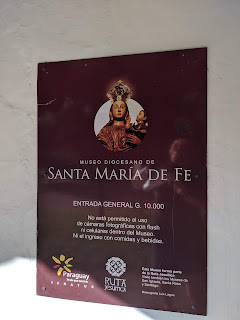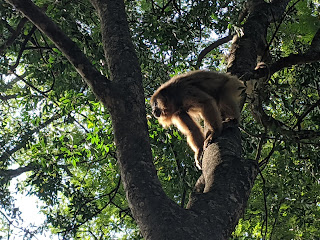We'd arrived late the day before after another very long day of travel in the so, so charming town of Santa Maria de Fe, the biggest of the Jesuit Reduction towns in the Missiones area of southern Paraguay.
The most important site in town was the Museo Diocesano de Artes Jesuiticas that had 54 cedar statues that had been carved by the indigenous Guarani and by their Jesuit teachers. The building itself was important as it was the only one on the plaza that had kept its design except connecting doors between the rooms were added to the original casas de indios or Indians' homes. When the casas were built, each room was for one indigenous family.
In the first room were wrought iron crosses that came from the top of the church and its bell tower across from the museum.
Janina: You'd have loved seeing in person this pair of St. Stanislaus Kostka statues! I loved seeing the pairs of statues, each carved by different artists although the Guarani had never carved anything before the arrival of the Jesuits. Seeing their skill at their newfound craft was remarkable! It was very evident that the smaller one had been carved
by a European because of the shape of the face and the hair was less curly
than its Guarani counterpart.
A statue of Santa Rosa de Lima was again present in this diocesan museum.
A pair of St. Luis Gonzaga statues: the larger one was carved by a Guarani and the smaller one by a Jesuit.
I would think it might be discouraging as the museum only received a half dozen visitors per week.

Michael the Archangel was again depicted as fighting the devil below him. Jose mentioned that as the fight never ended for the Guarani, the sword in Michael's hand was pointed upward. If you click on the photo to make it bigger, you will notice the Guarani carver represented the devil as a human.
In one of the last rooms was the famous crib of Santa Maria which was close to life-size.
The bird with the head crest was known as the perdiz or crested tinamou in English.
When the
Christ Child was stolen from the museum in 1983, a substitute was found
but it was not originally carved to be a Jesus. Jose thought though the figure of the seated Mary holding
a book was likely part of an Annunciation scene, it still fit well into
the scene as he eyes seemed to be gazing at the baby at her feet.


Two rooms in the casas had been knocked into one to become the powerful and emotional Room of the Passion. The Christ on the Donkey figure was still used in the church across the street on Palm Sundays.
The figure of St. Peter weeping as he heard the cock crow was very moving.
Behind him was the most expressive figure in the museum, that of a Virgin of Sorrows "looking upwards and so absorbed in the painful sight before her eyes."
This was Lelis, our teenage guide, who had so kindly opened up the museum for us and then proceeded to give us a room by room tour. She then took us across to the church with no expectation of being reimbursed. Anya was an absolute treasure, patiently taking her time to answer our questions with the sweetest of manners. I just wanted to hug her to pieces for sharing her love of the superb museum and her town! She spoke almost perfect English thanks to an Englishwoman, Margaret Hebblethwaite, who had moved to Santa Maria de Fe years ago, taught English in the school and also helped the local women develop crafts for sale.
Jose made sure we looked at the Paraguayan harp in the corner of the church as the harp was synonymous with his country.
Staying at the charming Santa Maria Hotel just across from the church was like a piece of heaven on earth. Being served dinner and breakfast in its enchanting courtyard was just perfect. The cost was only $32 for our B&B!
Next to our hotel, the only one in town by the way, was Taller de Hermanadad, the cooperative of 30 local women that sold items made with embroidered applique that were unique in Paraguay. Started by Hebblethwaite as a source of income for local women, the shop was located in a reproduction casa de indios. I was so looking forward to supporting the shop so was very disappointed to find the shop closed because they were getting free health checks nearby. Jose promised we could return in a few days on our way back to Asuncion - phew!
In the corner of the plaza directly across from the hotel was an original cross, one of four that used to stand in each corner.
On another corner was a small monument to Aime Bonpland, a world-famous 19th century French botanist who lived in Santa Maria de Fe for ten years.
Among the trees in the otherwise peaceful plaza was a family of howler monkeys! I could hear them right away as they made a fearsome racket but had trouble spotting them until Jose took pity on me.
Jose told us the monkeys enter their nests in the eucalyptus trees from the bottom, something I hadn't heard of other animals doing before.
Next to the hotel was a mural painted during a youth mission.
A few blocks away was a small hill called the Cerrito which was used during Jesuit times as a Calvary. The figure of Christ on the donkey that we'd seen in the museum is carried still today as the beginning of the Palm Sunday procession.
Vigilant Jose spotted a southern lapun bird on the hill.
The diocesan museum, the church, the plaza with its howler monkeys and, of course, the idyllic hotel in Santa Maria de Fe were all so utterly delightful and charming I could see why foreigners like Hebblethwaite and Bonpland had been drawn to live in the little piece of paradise for years and years. However, we could probably have stood on this road for several minutes without seeing anyone else or any cars pass by. Plus, there were no stores or restaurants anywhere we saw!
Next post: We did far more the rest of that day but I will leave it to the next post - stay tuned to discover the Guaranis' perceptions of the cosmos!
Posted on February 17th, 2020, from our home near Denver as we're scrambling to change three weeks in the middle of our upcoming four month long trip to Asia because of the coronoavirus! Not a bad problem to have, we well know, in the scheme of things but a tad inconvenient with our leaving in under two weeks.
























































No comments:
Post a Comment